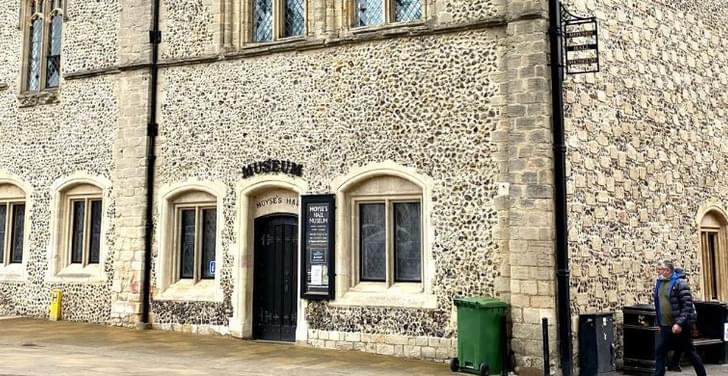
Back to Blogs
Discover
East Anglia and the Wolf
By Robin Herne
The image of the wolf runs deep in Suffolk, particularly in Bury St Edmunds where legend has it that a wolf guarded St Edmund’s head after he was slain. Robin Herne looks at why the wolf is a symbol for East Anglia.
Wolves in East Anglia

Photo: Aden Lewis
Wolves once roamed the woods of East Anglia, and their presence has leant a curious theme to our local history. Even before Roman times, the Iceni tribes of East Anglia were producing coins, called Iceni Staters, bearing the image of stylised wolves, pictured below. Exactly why Boudica’s tribe chose the wolf as a symbol is uncertain - maybe they worshipped a lupine god or goddess, maybe one of their royal dynasties had the wolf as an emblem, or maybe they just admired the beast for its strength and familial devotion. Whatever the case, the creature was clearly dear to their hearts.
When the Romans arrived in Britain they carried the wolf standard with them wherever they went, honouring the she-wolf Lupa who was said to have suckled the abandoned twin boys Romulus and Remus who eventually founded the Eternal City.
Every February 15th the Romans celebrated the Lupercalia, festival of the wolves, and doubtless those imperial citizens settled in our region marked this day too.
Wuffinga Dynasty

Most famously in this area, St Edmund is associated with the wolf. Sometime during the 570s the Anglo-Saxon King Wuffa (whose name means “Little Wolf”) acceded to the throne of the Eastern Angles. He became the sire of the entire Wuffinga dynasty, whose most illustrious member was King Raedwald. Amongst the treasures found in Raedwald’s ship burial at Sutton Hoo is the ornate gold and garnet clasp for a money bag. This clasp depicts a male figure (probably the god Woden) flanked by two wolves.
The last descendant of the Wuffinga line was King Edmund, who met his untimely end at an uncertain location (then called Haegelisdun) in Suffolk. Caught up in battle with the Great Heathen Army, he was tied to a tree and raddled with arrows – allegedly to force him to recant his Christian faith. When he refused to do so the leader of the Danes, Ivar the Boneless, ordered the lopping off of the king’s head. When Edmund’s followers discovered the decapitated body they searched in vain, till a wolf cried out in Latin, “here, here, here!” The linguistically gifted lupine was standing guard over the martyr’s head, and so features on various carvings, flags and suchlike all around Bury to this day.
Wolves at The Abbey

The wolf with St Edmund's head - Bury St Edmunds Guildhall
Bury also has another curious connection to our furry friends. The western tower of the abbey stood where an estate agents’ premises now resides.
When the area was being excavated, quite some years ago, archaeologists found a large pit containing many wolf skulls. The exact reason for this deposit, without benefit of a Tardis to check, can now only be a matter of conjecture.
Some historians hypothesise that this is evidence of some sort of sacrificial offering placed beneath the tower (if this seems odd in a Christian site, bear in mind that early Christianity often melded with pagan practices – for example, an entire bull was buried underneath the altar at Notre Dame cathedral in Paris).
Other historians, of a slightly less romantic turn of mind, conjecture that there might have been a furrier working near the tower who simply discarded unwanted bones in a pit. Many people wore wolf fur for warmth in centuries long past. If it was something as prosaic as a rubbish pit, then it still makes for a very curious coincidence that so many wolf skulls should be found near a sacred site with strong wolf imagery.
Saint Botolph

Wolf mural at The Angel Hotel
In another saintly vein, St Botolph – founder of the now derelict abbey at Colchester and patronym of the town train station – once established various churches, abbeys etc. around the region. A number of the items dedicated to him in centuries past, such as the stone cross from at the Suffolk village of Iken, bear the heads of what are either wolves or dogs.
The story goes that the hermit retired to the marshes of Suffolk to contemplate God. When assorted marsh demons attempted to distract him and prevent the building of churches, he found aid from either a large wolf or possibly dog. This became his especial companion. Botolph is one of the few saints to sometimes be depicted in early iconography as having the head of a wolf or dog (the topic of one of the short stories in my murder mystery anthology, ‘A Dangerous Place’ published by Moon Books). His feast day is June 17th, and Botolph is regarded as a patron saint of both travellers and farmers.
Christianity has a somewhat mixed relationship with the natural world and its flora and fauna. The ancient pagan religions made extensive use of natural imagery, which may explain why the early Church seemed somewhat ambiguous about embracing imagery that was so associated with the religions it was trying to displace. Shepherding was a way of life for many of the peoples amongst whom Christianity first emerged, and the iconography of Jesus as the Good Shepherd stands proud within ecclesiastical tradition. Shepherds seldom have a high opinion of creatures such as wolves, which are prone to devour the occasional lamb. It comes as no great surprise that the early Church often used the image of the wolf as a symbol of the Devil predating upon the flock of Jesus. Sadly this attitude in no small part contributed to the irrational fear of a creature that has never been any real risk to humanity, but has nonetheless been driven close to extinction by our superstitious paranoia.
This article first appeared in the East Anglian Daily Times and is published here with permission from the newspaper and its author Robin Herne, lecturer in Religious Studies at UCS Bury St Edmunds.
Related Blogs

News
Tours Take Off for Masters of…
Tours developed by Bury St Edmunds Tour Guides and…

News
Vote for Bury St Edmunds Tour…
Vote now to Help Bury St Edmunds Tour Guides win the…

News
See Rendlesham Revealed at…
1,400-year-old Anglo-Saxon artefacts from National…

News
New afternoon tea at Lavenham…
Enjoy a Masters of the Air themed afternoon tea at The…

News
Itinerary: Masters of the Air
Follow in the footsteps of the Master of the Air
Latest news

News
Discover Suffolk's County Flower - the Oxlip
Did you know that Suffolk has a county flower? The Oxlip only grows in some woodland areas of Suffolk, Cambridgeshire and Essex.

News
Quentin Blake ‘The Illustrated Hospital’ exhibition at Bury St Edmunds Museum
A summer exhibition of illustrations by Quentin Blake at Moyse’s Hall Museum, Bury St Edmunds presents a rare opportunity to view a large collection of pieces by one of the nation’s favourite artists.

News
Abbey Project Awarded National Lottery Heritage Fund Grant
The project aims to conserve and protect the ruins; build a visitor centre, west cloister, and network of footpaths; and use digital technology to provide exciting interpretation for all ages and…

News
Walks at Rougham
Rougham Estate offers 18 miles of public footpaths, cycling routes and permissive pathways for you to enjoy.

News
Bury St Edmunds Celebrates English Tourism Week
Bury St Edmunds MP, Jo Churchill, met representatives from the town’s attractions and tour guides involved with the town’s Masters of the Air tourism campaign at Bury St Edmunds Guildhall.

News
Tours Take Off for Masters of The Air
Tours developed by Bury St Edmunds Tour Guides and Bury St Edmunds Guildhall to tie in with the Apple TV Series Masters of The Air so popular more dates are being added.

News
International illustrator David Hughes draws largest exhibition Bury St Edmunds
The largest ever exhibition is now underway at Moyse’s Hall Museum featuring the work of internationally acclaimed illustrator David Hughes.

News
A Taste of Bury St Edmunds and Suffolk
After visiting Suffolk's foodie capital, you'll want to take it with you - here are 5 foodie treats to take home!

News
Doctor Who Stars Coming to Bury St Edmunds to Star in Sherlock Holmes Classic
Who stars Colin Baker, Terry Molloy, and Rosie Baker will star in Hound of The Baskervilles at Bury St Edmunds Theatre Royal
